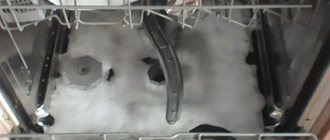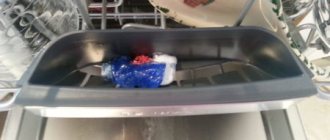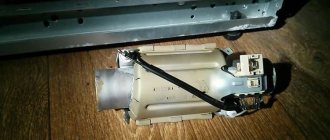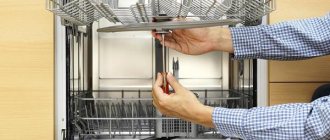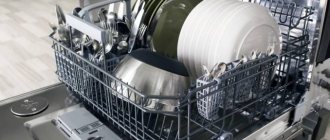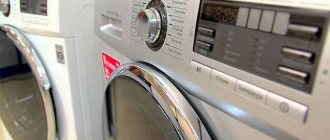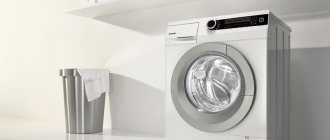Classification
International classifications evaluate a dishwasher in three dimensions:
- Power consumption.
- Washing class.
- Drying quality.
The first parameter is estimated in consumed kWh. The range of values extends from A+++ (less than 50) to D (over 90). Other assessed groups are marked with the letters A to G. The dishwasher drying class is assessed by a special ID index. For example, for models designed for 8 or more devices, the parameter exceeds 1.08, for others - 0.86.
Any letter is assigned the following range of values:
- over 1.08;
- 0,86 – 1,08;
- 0,69 – 0,86;
- 0,55 – 0,69;
- 0,44 – 0,55;
- 0,33 – 0,44;
- less than 0.33.
The lower limit of the range is not included here. These figures, which evaluate the drying efficiency of a dishwasher, say little to the eyes of a person not privy to the intricacies of calculating the parameter. In light of this fact, it is proposed to briefly familiarize yourself with the methodology.
Drying efficiency index
To calculate the parameter, a fictitious reference dishwasher with certain characteristics is used. The European Union promises to regularly update the publicly available calculation methods in the Official Journal and to constantly indicate the numbers necessary for performing mathematical operations.
The tests involve at least five measurements. The logarithm of the index ln(ID) is calculated by summing the elementary logarithms of the ratios of drying efficiencies for each measurement of the series. The numerator is the parameter of the product being tested, and the denominator is the parameter of the reference product. The resulting amount is divided by the number of tests.
The resulting coefficient is calculated by raising the number e (the base of the natural logarithm, 2.71828182...) to the power ln(ID). It is easy to notice that the drying of a dishwasher that does not differ from the reference one receives an index of 1.
Don't be intimidated by the complexity of the calculations. Drying efficiency takes a value of 0 – 2, selected from a table describing the result of the operation. The higher the number, the better the efficiency.
The amount of wet streaks and traces remaining after drying is subject to assessment. When leaving the dishwasher, 100% dry plates are assigned a value of 2. The appearance of one drip or no more than 2 traces with a total area within 50 mm2, the drying efficiency has dropped to 1. The equipment with the worst performance receives a rating of 0.
Since you cannot divide by zero, the drying efficiency of the reference dishwasher is not zero, unlike the test samples, which are given lower ratings. The standard does not give a specific value (but says that it is better to look for information in the Official Journal), does not have to be an integer. The conclusion suggests itself is that the drying efficiency value of a reference dishwasher will be unity. In fact, the explanation is simple. The measuring standards of a parameter are called units:
- meter is a unit of length;
- second is a unit of time;
- decibel is a unit of loudness.
In conclusion, it is worth noting that, unlike the energy consumption class, which is improved literally ad infinitum by putting pluses after the letter A, the drying coefficient index is no more than a fixed value and a completely achievable ideal, above which it is no longer possible to rise. In this case, the drying index of the reference machine falls into efficiency class B. This is easy to see from the information in the previous subsection.
Types of drying
Now that it is clear how to calculate the mysterious-sounding parameter drying efficiency index and determine the class of a product, it’s time to move on to consider how designers put theory into practice.
The dishwasher is equipped with the following drying options:
- Condensation
- Active.
- Turbo.
The varieties are listed in order of increasing energy consumption. Condensation drying occurs in a semi-natural way. The moisture evaporates on its own, collecting on the heat exchanger or the inner walls of the chamber. The drops flow down in streams. Condensation drying delays the process to the maximum, energy consumption is close to zero.
There are no visible processes happening; from the outside it looks like the dishwasher has finished working, but does not turn off. In reality, the equipment is simply waiting for the plates to dry.
Active drying is based on air circulation. Moist hot streams rise upward, enter the heat exchanger path, where drops settle on the cold walls of the channel, and the air, under the influence of natural processes, falls down the pipe and re-enters the dryer.
A minimum of energy is required to remove the generated heat; energy consumption increases slightly. Active drying in the dishwasher will be the golden mean. This reduces the full cycle time.
The last mode is considered forced air blowing of the dishes. As you know, it dries faster in the wind; moisture is carried away by the passing stream. Turbo drying in a dishwasher shortens the cycle as much as possible at the cost of additional energy consumption. This option is indispensable when maximum speed is required.
Condensing or capacitor type
This is one of the first dryers that appeared in dishwashers; it is still used in Bosch and Milli models. Some manufacturers mark it as turbothermic or static.
The dishes dry naturally, which saves energy. At the end of washing, the devices are doused with hot water, then the hopper door begins to smoothly open. Due to the temperature difference, condensation collects on the walls of the compartment, which subsequently flows into a special compartment.
+ saving resources, the result is satisfactory.
- long wait, plates can take a day to dry.
BoschSMV 40D20
The built-in machine will provide excellent washing and drying of dishes. Capacity for 13 sets, i.e. dinner for a large family and the arrival of guests will not burden the hostess - all the dishes will be washed perfectly.
Dishwashers from Bosch are distinguished by high build quality and performance. This model has a useful “1/2 load” mode. Cost from 23 thousand - the optimal ratio of quality and price.
Flavia BI 60 KAMAYA
A spacious machine for 14 sets, very economical (A+++), not noisy during operation. The advantages include 8 operating modes. The dishwasher is completely protected from leaks and power outages.
Express mode technology leaves much to be desired - reviews indicate incomplete drying in this mode. Otherwise, they find only advantages. The price for Flavia is from 27 thousand rubles.
Siemens SR 64M006
The capacity of this unit is up to 8 sets; it will wash dishes from 3-5 people perfectly. The number of programs is standard, the case is protected from leaks, there is child protection and other useful modes.
Turbo drying mode
This process is carried out by circulating air through a circuit inside the dishwasher. A characteristic feature is the absence of a fan in the design; the case has a special air intake.
Intensive drying is carried out due to pressure differences, which, in turn, arise due to different temperatures in the water storage and washing chambers.
This mode is worth choosing if you need absolutely dry dishes that do not need to be further wiped with a towel. User reviews indicate that, compared to condensation models of dishwashers (Electrolux, Bosch), this type copes with its responsibilities much more effectively, without leaving streaks, drops or stains.
For consumers who value time and do not want to wait for plates to dry naturally, manufacturers produce dishwashers with a built-in turbo dryer. Such PMM models are more expensive because they require the installation of additional functional elements - a heating element and a fan.
The operating principle of turbo drying, which is often called convection or convective, provides for a constant supply of hot air:
- The heating element heats the air inside the chamber.
- The fan circulates hot air and blows over wet dishes.
- Plates, cups and glasses dry quickly, so the operating time of a dishwasher with turbo drying is reduced several times.
We suggest you familiarize yourself with How to remove rust from tulle
For all their advantages, machines of this type have a number of disadvantages. They are characterized by a high price and increased energy consumption required to operate the heating element and fan. Devices that increase air temperature and blow air over kitchen utensils may fail during operation. And this will require their repair and additional cash expenses.
A dishwasher with intensive or active drying ensures reduced energy consumption, as well as complete drying of glass, metal and ceramics without drips or streaks on the surface.
To achieve this effect, design engineers applied the laws of physics, providing for the installation of a special heat exchanger with cold water. Due to the temperature difference between its walls and the internal surfaces of the washing cabinet, a difference in air pressure occurs, forcing air flows to constantly circulate throughout the chamber.
Dishwashers with an intensive drying type combine several advantages:
- affordable price;
- economical energy consumption;
- high quality processing of dishes, on which there are no streaks or drops of water.
The process of drying dishes does not require the installation of heating elements and fans that can fail at the most inopportune moment. Therefore, the likelihood of damage to the dishwasher dryer is minimal.
The design of dishwashers with turbo drying is more complex. In addition to the usual parts, they have a heating element for producing hot air and a fan for blowing wet dishes. Turbo drying proceeds in the following way:
- The heating element and fan, which are located in a chamber protected from moisture, provide a continuous supply of hot air.
- This air stream continuously blows on the wet dishes and dries them.
It’s not difficult to guess that a dishwasher equipped with a turbo dryer copes with the task much faster: the model is good for those who want to get the fastest results. However, you will have to pay much more for such equipment than for a model with a capacitor, and it will draw more electricity.
The design of the dryer has additional spare parts needed to produce hot air, so the likelihood of failure of one of them is high. If the heating element burns out or the fan breaks, the dishwasher will not dry the dishes due to a violation of the optimal temperature regime.
Machine with turbo dryer
In order to make dishwashing machines a little cheaper, manufacturers decided to use the laws of physics of heat exchange processes for the drying process in some models. This is how machines with an intensive type of drying appeared. The principle of their operation is as follows:
- Water enters the cold chamber of the water collector, and air enters the adjacent chamber through special openings.
- Due to the temperature difference between the water collector and the walls of the washing cabinet, a pressure difference arises, which forces the incoming air to circulate.
- Intense air movement dries out moisture on dishes.
Thus, in a dishwasher with a heat exchanger there is no heating element and fan. An improved device, which appeared relatively recently, made it possible not only to reduce the cost of the device, but also to ensure that it consumes as little electricity as possible.
In addition to the types of drying in dishwashers, their classes are also distinguished. The letters “A” and “B” can often be found in descriptions of the characteristics of dishwashing machines. Drying of the highest class “A” ensures completely dry dishes, class “B” allows for the presence of some moisture.
And very often the dishwasher does not dry the dishes due to improper loading or excessive overloading of the washing cabinet. In order for the device to serve for a long time, not break down and cope well with its functions, you should follow simple rules for its operation.
Which type of drying is best?
To choose a dishwasher with the best drying type, you need to consider several factors:
- reasonable cost of the unit;
- frequency of use;
- the importance of drying speed;
- the importance of the appliance's energy consumption.
If you need the most budget option, then you should purchase a unit with passive drying . It does not require additional energy consumption and is simple in design. You can adapt and wash the dishes in the evening so that the dishes dry naturally overnight.
A model with active drying will cost a little more . Its important advantage is that it does not operate using electricity, but using certain laws of physics.
Turbo drying attracts with its high speed of the process and its efficiency. The cost of dishwashers with such a system is at an average level. It is important to know that turbo drying means additional energy costs, so routine maintenance of such a unit will cost more.
Zeolite drying is attractive in many respects, but is currently only available in some models. Their cost is quite high, so only a few can afford such a unit. The same factor applies to smart devices. The modern pace of life will soon lead to new inventions, so the latest achievements will become available en masse and will significantly decrease in price.
It is impossible to say with certainty which type of dishwasher dryer is better. The choice depends on the financial capabilities and needs of the consumer. Everyone can choose the optimal set of parameters (see how to choose a dishwasher).
Condensation
This type of drying is the most common. Drying of dishes in condensation-type units occurs naturally due to the temperature difference:
- Clean dishes are washed with almost boiling water.
- Hot steam, in contact with the cold walls of the dishwasher, condenses and turns into droplets of water.
- The resulting condensate drains and is then pumped out through the drain hole with a special pump.
The condensation type of drying in a dishwasher has a number of advantages, which include complete silence and efficiency (the unit does not work while drying cutlery and does not consume electricity). Built-in dishwashers with condensation drying are cheaper than their counterparts with turbo drying or zeolite.
This option also has disadvantages. Unattractive stains and drops of water may remain on the surface of plates and glasses, which will have to be removed manually. In addition, it takes several hours for the dishes to dry completely. Therefore, experts advise loading cutlery in the evening so that you can get dry dishes in the morning.

